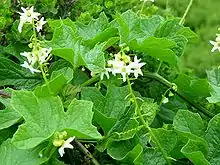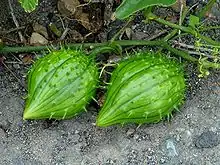Marah oreganus
Marah oreganus, the Oregon manroot, coastal manroot or western wild-cucumber,[1] is a common manroot of the northwest coast of the United States. It ranges from California north to Canada.
| Marah oreganus | |
|---|---|
 | |
| Scientific classification | |
| Kingdom: | Plantae |
| Clade: | Tracheophytes |
| Clade: | Angiosperms |
| Clade: | Eudicots |
| Clade: | Rosids |
| Order: | Cucurbitales |
| Family: | Cucurbitaceae |
| Genus: | Marah |
| Species: | M. oreganus |
| Binomial name | |
| Marah oreganus | |
| Synonyms | |
|
Marah oregana | |
Foliage
Coastal manroot has the least pubescent bud, leaves, and branches of all the manroot species. Populations in more northern climates are nearly hairless with glossy leaves. Vines appear in late winter or early spring in response to increased rainfall, and can climb or scramble to a length of 6m. Its leaves typically have five lobes with individual plants showing wide variation in leaf size and lobe length. Although leaf size is highly variable, coastal manroot tends to have larger leaves than other Marah species.
Vines emerge from a large, hard tuberous root which can reach several meters in length and weigh in excess of 100 kg. Newly exposed tubers can be seen along roadcuts or eroded slopes and have a scaly, tan-colored surface. Injured or decaying tubers take on a golden or orange color.
Flower
The flower can vary in color from yellowish green to cream to white. Flowers appear soon after the vine emerges. The flowers are monoecious, that is, individual flowers are either male or female, but both sexes can be found on the same plant. Male flowers appear in open spikes while females flowers, distinguished by a swollen base, usually appear individually. The plant is self-fertile, i.e. pollen from the male flowers can fertilize the female flowers on the same plant; pollination is by insects.
Fruit
The fruit is spherical, 4–5 cm in diameter, and covered in prickles of variable density, up to 1 cm long but without hooks. Unripe fruit are bright green, ripening to yellow. The fruit swells as it ripens until finally rupturing and releasing the large seeds. Fruit begin to form in spring and ripen in summer.
Seeds and germination
Seeds of the coastal manroot are large, hard, and smooth. Unlike the bullet-shaped seeds of other Marah species, coastal manroot seeds are more flattened and disc-like. Fruit usually hold 4 or more seeds. Seeds have an intriguing germination process. The initial shoot emerges from the seed and grows downward into the earth. This shoot then splits, one part beginning to swell and form the tuber, while the second part grows back to the surface and becomes the vine.
The seeds may be fatally poisonous.[2]
Habits
Coastal manroot grows most vigorously by streams or in washes but can also be successful in dryer areas, at elevations up to 1600 metres. It will tolerate a variety of soil types and acidities, but it requires at least seasonally moist soil. Vines can grow in full-sun to heavily shaded conditions. In mild areas of its range where year-round moisture is available, vines are perennial. In cold winter areas, vines die back in fall. In areas with seasonal wetness, vines emerge at the beginning of the wet season and die back completely in the dry season.
Uses
All parts of the plant have a bitter taste (this is the meaning of the genus name Marah, which comes from Hebrew). The fruit is inedible.[3] Some Native Americans may have consumed the seeds to commit suicide.[2] The large tuber of the manroot can be processed for a soap-like extract.
Medicinal uses
Marah oreganus was used by the Native Americans for various health problems. The Chinook made a poultice from the gourd. The Squaxin mashed the upper stalk in water to dip aching hands. The Chehalis people burned the root and mixed the resulting powder with bear grease to apply to scrofula sores. The Coast Salish made a decoction to treat venereal disease, kidney trouble and scrofula sores.
Toxicity
The leaves and fruit contain high concentrations of tetracyclic triterpenoid compounds known as cucurbitacins. They impart a bitter flavor which serve as a natural pest deterrent. When ingested they can lead to various degrees of gastrointestinal upset and dehydration. Although data for this specific variety of wild cucumber is limited, case reports of ingestion of other species within the Cucurbitaceae family have been found to induce severe illness requiring intensive care support to treat dehydration from the profound gastrointestinal distress.[4] There is no specific antidote.
These compounds have also been reported to induce delayed alopecia although the mechanism is unknown.[5]
Gallery
 Fruits
Fruits Flower
Flower Leaf
Leaf Flowers
Flowers
References
- "Marah oreganus". CalPhotos. University of California, Berkeley. Retrieved July 31, 2011.
- Benoliel, Doug (2011). Northwest Foraging: The Classic Guide to Edible Plants of the Pacific Northwest (Rev. and updated ed.). Seattle, WA: Skipstone. p. 209. ISBN 978-1-59485-366-1. OCLC 668195076.
- Fagan, Damian (2019). Wildflowers of Oregon: A Field Guide to Over 400 Wildflowers, Trees, and Shrubs of the Coast, Cascades, and High Desert. Guilford, CT: FalconGuides. p. 43. ISBN 1-4930-3633-5. OCLC 1073035766.
- Kusin S, Angert T, Von Derau K, Horowitz BZ, Giffin S. “Toxic Squash Syndrome: a case series of diarrheal illness following ingestion of bitter squash, 1999-2011.” Clin Toxicol 2012; 50(7):658.
- Assouly, Philippe (2018-05-01). "Hair Loss Associated With Cucurbit Poisoning". JAMA Dermatology. 154 (5): 617. doi:10.1001/jamadermatol.2017.6128. ISSN 2168-6068.